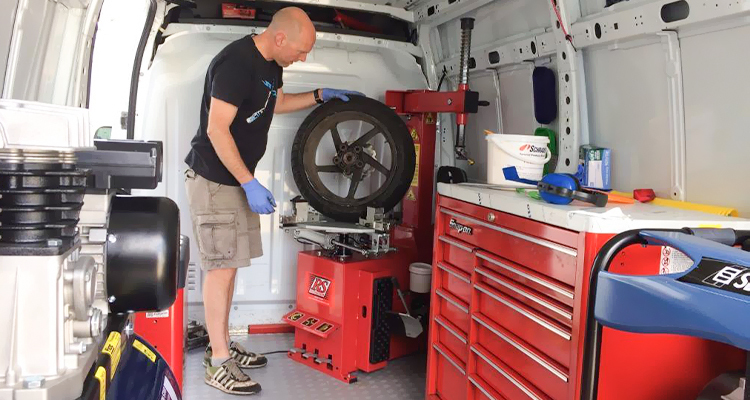Tire Solution: Proven Approaches for Optimum Tire Upkeep and Care
From making certain correct tire stress to routine turning and alignment, there are tried and tested approaches that can dramatically prolong the life-span of your tires and improve general driving experience. Allow's dig right into the world of tire service and find the keys to maintaining your tires in excellent shape for the long haul - Mobile Tire Change Las Vegas.
Value of Tire Pressure
Sufficient tire stress advertises far better gas performance, as under-inflated tires can lead to boosted rolling resistance, triggering the engine to work more challenging and take in more fuel. Appropriate tire stress guarantees even step wear, improving tire long life and conserving cash in the lengthy run by delaying the demand for premature replacements. Frequently inspecting and adjusting tire pressure, especially before long trips, is a straightforward yet efficient means to improve lorry efficiency, extend tire life expectancy, and focus on safety and security on the road.
Tire Turning Standards
When thinking about tire rotation standards, it is vital to recognize the significance of this maintenance task in making the most of tire life-span and maintaining optimum automobile efficiency. Tire rotation entails changing the setting of each tire on an automobile to make sure even step wear. Front tires often tend to put on quicker than back tires because of guiding pressures, making routine rotation critical for balanced wear patterns. The advised turning pattern differs depending on whether a car is front-wheel, rear-wheel, all-wheel, or four-wheel drive. Normally, tires should be revolved every 5,000 to 7,500 miles, or as advised in the lorry manual. Overlooking tire rotation can result in unequal wear, affecting handling, grip, and potentially compromising automobile safety. By sticking to appropriate rotation standards, motorists can prolong the life of their tires, enhance gas efficiency, and improve total driving experience. Regular turning is an easy yet effective maintenance technique that adds considerably to tire longevity and vehicle performance.

Advantages of Wheel Placement
Making sure appropriate wheel positioning after tire turning is crucial for preserving well balanced wear patterns and making best use of car performance. Additionally, proper wheel alignment assists to prolong the life-span of your tires. Misaligned wheels can create irregular tire wear, leading to early tire substitute and enhanced maintenance costs.

Tire Footstep Depth Examine
Executing a routine examination of tire tread depth is essential for maintaining secure driving conditions and lengthening the life expectancy of your tires. Irregular step wear can indicate problems with tire pressure, placement, or suspension, highlighting the significance of routine step depth checks. By including tire step depth checks into your routine upkeep timetable, you can drive with confidence knowing that your tires are in leading problem.
Seasonal Tire Inspection
A detailed analysis of tire condition tailored to specific climate condition is vital my link for maintaining optimal efficiency and security throughout the year. Seasonal tire examination is an essential facet of tire upkeep that makes certain tires are all set to encounter the difficulties posed by different weather. To prepare for winter months, it is crucial to examine the tire pressure routinely as cool temperature levels can create tire pressure to go down. Inspecting tire tread deepness is additionally essential to ensure appropriate grip on snow and frozen roadways. In addition, looking for indications of wear and tear, such as splits or lumps, can assist stop potential tire failures. As the periods change, it is crucial to evaluate tire problem and make any kind of required changes to assure secure driving. By performing regular seasonal tire assessments, drivers can prolong tire life expectancy, improve fuel efficiency, and most notably, guarantee a safe and secure driving experience in varying climate condition - Flat Tire Repair Las Vegas.
Verdict
In verdict, preserving appropriate tire stress, turning tires frequently, straightening wheels properly, keeping track of step deepness, and carrying out seasonal inspections are crucial methods for optimal tire care. By complying with these confirmed methods, chauffeurs can ensure their tires last much longer, do better, and add to overall lorry safety and security. It is essential to prioritize tire maintenance to protect against accidents, enhance gas performance, and lengthen the lifespan of tires.
Adequate tire stress advertises far better fuel effectiveness, as under-inflated tires can lead to enhanced rolling resistance, triggering the engine to work tougher and eat even more fuel.When taking into consideration tire turning standards, it is essential to understand the relevance of this maintenance task in taking full advantage of tire lifespan and maintaining optimum lorry efficiency. Seasonal tire inspection is a basic aspect of tire upkeep that makes sure tires are ready to deal with the challenges positioned by different weather condition problems. By performing routine seasonal tire inspections, chauffeurs can prolong tire life-span, enhance gas he said efficiency, and most notably, guarantee a protected driving experience in differing climate conditions.
In final thought, keeping appropriate tire pressure, turning tires regularly, aligning wheels properly, checking step depth, and carrying out seasonal inspections are important techniques for optimum tire treatment.